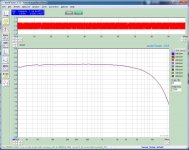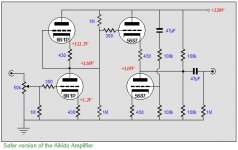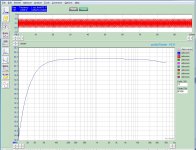Hi All,
Tried searching but didn't find anything, sorry if this is covered somewhere.
I just built an Aikido pre-amp from the 9-pin all in one kit. When I listen to it, it sounds very good but I seem to notice that I am hearing more bass than with my passive-pre that I was using. The passive pre is still in my path feeding the aikido. Suspicious that the Aikido is not increasing the bass but attenuating the treble I connected it up to my sound card to do a frequency sweep using Audio Tester software.
I do indeed see a rolloff of high frequency beginning at 3khz and down about 0.9db at 20khz. I verified the setup with a Pass B1 clone I have and it's only down about 0.1db at 20khz so seems like the setup is OK.
My question is if it's possible to add another cap in parallel with my output cap to reduce the high frequency roll-off?
I am currently using a pair of 2.2uf mundorf M Cap Supreme POI.
I don't know if this would have any affect but spice modelling does not show this roll-off. It shows freq resp flat up to ~350khz so I can't really model the situation. Seems to me the model of the output cap is probably not accurate. The other attributes such as gain and THD were modelled very accurately in my spice schem. I do realize my m-audio 2496 has limited bw so I'm not expecting see higher frequencies than in the trace.
Maybe you'll tell me this roll-off is insignificant to the sound and that's not what I'm hearing. The Aikido sounds very good.
Attached is the freq sweep and aikido schem for reference
Thanks in advance for any help/advice
Tried searching but didn't find anything, sorry if this is covered somewhere.
I just built an Aikido pre-amp from the 9-pin all in one kit. When I listen to it, it sounds very good but I seem to notice that I am hearing more bass than with my passive-pre that I was using. The passive pre is still in my path feeding the aikido. Suspicious that the Aikido is not increasing the bass but attenuating the treble I connected it up to my sound card to do a frequency sweep using Audio Tester software.
I do indeed see a rolloff of high frequency beginning at 3khz and down about 0.9db at 20khz. I verified the setup with a Pass B1 clone I have and it's only down about 0.1db at 20khz so seems like the setup is OK.
My question is if it's possible to add another cap in parallel with my output cap to reduce the high frequency roll-off?
I am currently using a pair of 2.2uf mundorf M Cap Supreme POI.
I don't know if this would have any affect but spice modelling does not show this roll-off. It shows freq resp flat up to ~350khz so I can't really model the situation. Seems to me the model of the output cap is probably not accurate. The other attributes such as gain and THD were modelled very accurately in my spice schem. I do realize my m-audio 2496 has limited bw so I'm not expecting see higher frequencies than in the trace.
Maybe you'll tell me this roll-off is insignificant to the sound and that's not what I'm hearing. The Aikido sounds very good.
Attached is the freq sweep and aikido schem for reference
Thanks in advance for any help/advice
Attachments
Very unlikely to be the output cap. Increasing the output cap would reduce LF rolloff, not HF rolloff.
Stray capacitance in the circuit might do it, especially if it gets multiplied by Miller effect in the first stage. The critical points are the first triode grid and anode circuits, and strays between these two points.
Stray capacitance in the circuit might do it, especially if it gets multiplied by Miller effect in the first stage. The critical points are the first triode grid and anode circuits, and strays between these two points.
Very unlikely to be the output cap. Increasing the output cap would reduce LF rolloff, not HF rolloff.
Stray capacitance in the circuit might do it, especially if it gets multiplied by Miller effect in the first stage. The critical points are the first triode grid and anode circuits, and strays between these two points.
OK, I'll think about what you're saying and try to understand/analize. But wanted to mention I wasn't thinking in the direction of increasing cap value (although anything in parallel would) but instead wondering if some small value cap in the nono or pico farad range in parallel could pass the high frequencies more efficiently than the big 2.2uf PIO. I'm probably just showing my ignorance.
Sound cards rarely have flat frequency responses so you are probably recording the intrinsic roll off of the sound card rather than the preamp.
I spent a very frustrating day working this out after I lost my good signal generator and tried to use my computer as a substitute.
Shoog
I spent a very frustrating day working this out after I lost my good signal generator and tried to use my computer as a substitute.
Shoog
Sound cards rarely have flat frequency responses so you are probably recording the intrinsic roll off of the sound card rather than the preamp.
I spent a very frustrating day working this out after I lost my good signal generator and tried to use my computer as a substitute.
Shoog
OK, my next plan then will be to take some gain measurements at different frequencies with my scope and see If It matches the scan or not. If I do see it I can move to the input of the cap and then the output of the 1st stage to isolate.
So, you guys fell the output cap I mentioned should not be limiting high freq response then?
thanks
Phil
A small capacitor across the 430 ohm cathode resistor on the bottom 6N1P might give a slight high frequency boost.
Thanks Frank, if I find the 1st stage to be contributing I'll look into that.
OK, this may have been a false alarm. I was using some cheap interconnects to attach to sound card. I switched to some better ones and the sound card sweep improved significantly. Both the Aikido and the B1 buffer now show about the same...down 0.3dB at 20khz. I'm guessing this probably isn't the difference in the sound when I'm listening to music.
So, getting back to that, I guess I'm just hearing the difference between tube and solid state. I'd like to understand the source of it but not sure I ever will.
When I originally said I'm hearing more presence in the bass with this pre I didn't necessarily mean it was bad. Just different than what I was used to. If there was a high frequency loss I certainly wanted to address it.
Previously I was listening to a passive-pre using autoformers driving a Pass F5 clone attached to Martin Logan electrostatics. I had been listening to this for about 6 months and was very happy with it. So, here, we had an autoformer attached to a J-fet gain stage followed by mosfets driving the speakers.
Now with the Aikido I've simply inserted it between the passive pre and F5. The sound is different and it sounds very good. It has more bass and other qualities that are difficult to describe. I think I like it better. The reason I built the tube pre is because I''m also building a Pass F4 clone, which has no gain. So, ultimately the j-fet gain stage will be gone and replaced by the tube gain stage.
One aspect of this change that may be contributing to the difference is that with the Aikido I have better drive of the F5 input stage. Although I'm still driving the Aikido input stage with the same autoformer through that same interconnect.
thanks guys
So, getting back to that, I guess I'm just hearing the difference between tube and solid state. I'd like to understand the source of it but not sure I ever will.
When I originally said I'm hearing more presence in the bass with this pre I didn't necessarily mean it was bad. Just different than what I was used to. If there was a high frequency loss I certainly wanted to address it.
Previously I was listening to a passive-pre using autoformers driving a Pass F5 clone attached to Martin Logan electrostatics. I had been listening to this for about 6 months and was very happy with it. So, here, we had an autoformer attached to a J-fet gain stage followed by mosfets driving the speakers.
Now with the Aikido I've simply inserted it between the passive pre and F5. The sound is different and it sounds very good. It has more bass and other qualities that are difficult to describe. I think I like it better. The reason I built the tube pre is because I''m also building a Pass F4 clone, which has no gain. So, ultimately the j-fet gain stage will be gone and replaced by the tube gain stage.
One aspect of this change that may be contributing to the difference is that with the Aikido I have better drive of the F5 input stage. Although I'm still driving the Aikido input stage with the same autoformer through that same interconnect.
thanks guys
I'm not saying you didn't think of this, but is the Pass B1 clone in the signal path of your test setup? If so think of this:
Pass B1 clone volume control + interconnect capacitance + 50K volume control of the Aikido.
No the b1 wasn't in the path when I was testing with sound card. It wasn't in the path when I was listening either. Just something I pulled off the shelf for the comparison test.
Also, my Aikido has no volume control. I use my passive-pre for that, which is build out of Dave Slagle's autoformers.
Last edited:
Whenever I've used a passive pre in my system, there always has been a perceived boost in LF at low volume.
My passive-pre was in the path at all times for listening, before and after Aikido addition.
Hi,
Looks consistent with high output impedance driving cable capacitance.
rgds, sreten.
It's a low output impedance design.
------------------------
I measured my Aikido with 6SN7s and it was ruler flat past 20k.
I'd guess it's the result of capacitance at the input, as cogsncogs said...
I am running a DAC > 20k volume attenuators > Aikido
I found out you need to take the frequency sweeps in audioTester using one input channel as the reference to remove sound card deviations.
After doing that the Aikido is -1dB at 10Hz and then basically flat from 50 to 50k which is the highest I can measure. So, all is well.
Dave, what tubes are you running? I have 6cg7/6dj8 currently. My options for the first stage are limited because I don't want more than a gain of 10, or so. Just curios.
After doing that the Aikido is -1dB at 10Hz and then basically flat from 50 to 50k which is the highest I can measure. So, all is well.
Dave, what tubes are you running? I have 6cg7/6dj8 currently. My options for the first stage are limited because I don't want more than a gain of 10, or so. Just curios.
Attachments
Last edited:
I found out you need to take the frequency sweeps in audioTester using one input channel as the reference to remove sound card deviations.
After doing that the Aikido is -1dB at 10Hz and then basically flat from 50 to 50k which is the highest I can measure. So, all is well.
Dave, what tubes are you running? I have 6cg7/6dj8 currently. My options are limited because I don't want more than a gain of 20, or so. Just curios.
That looks good! I'm running 6SN7s in and out....
That looks good! I'm running 6SN7s in and out....
Cool, 6sn7 and 6cg7 are supposedly the same electrically.
- Status
- This old topic is closed. If you want to reopen this topic, contact a moderator using the "Report Post" button.
- Home
- Amplifiers
- Tubes / Valves
- output cap bypass?


